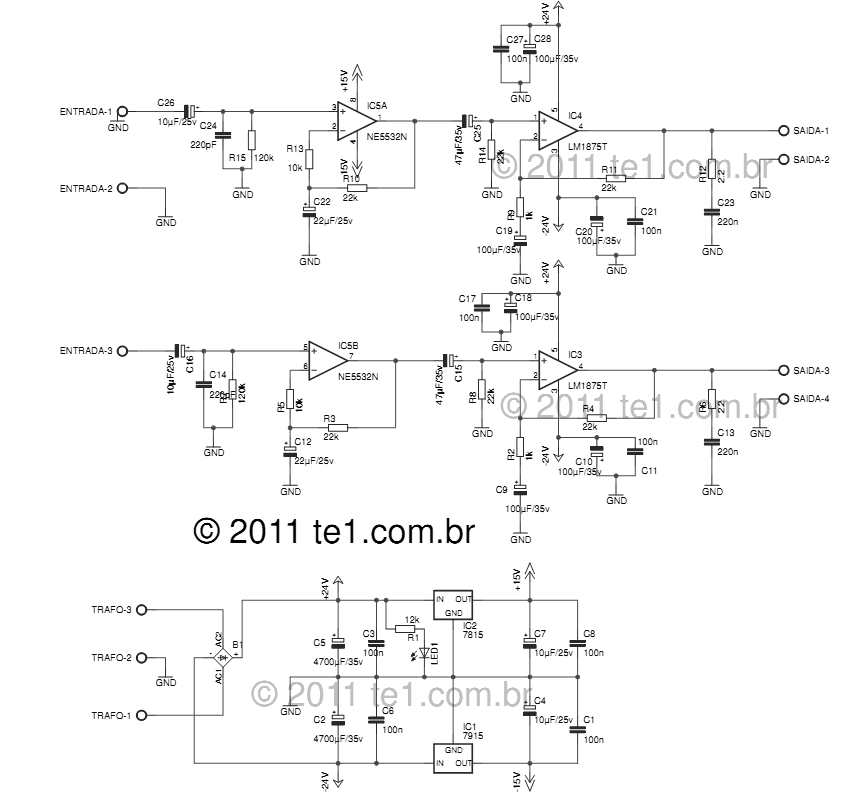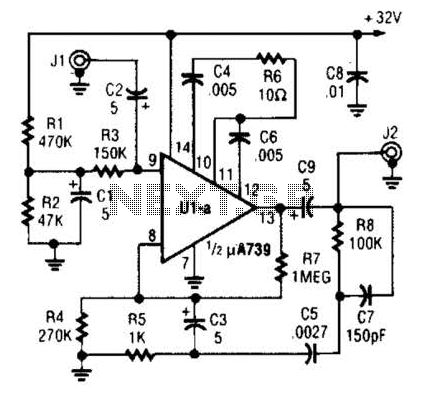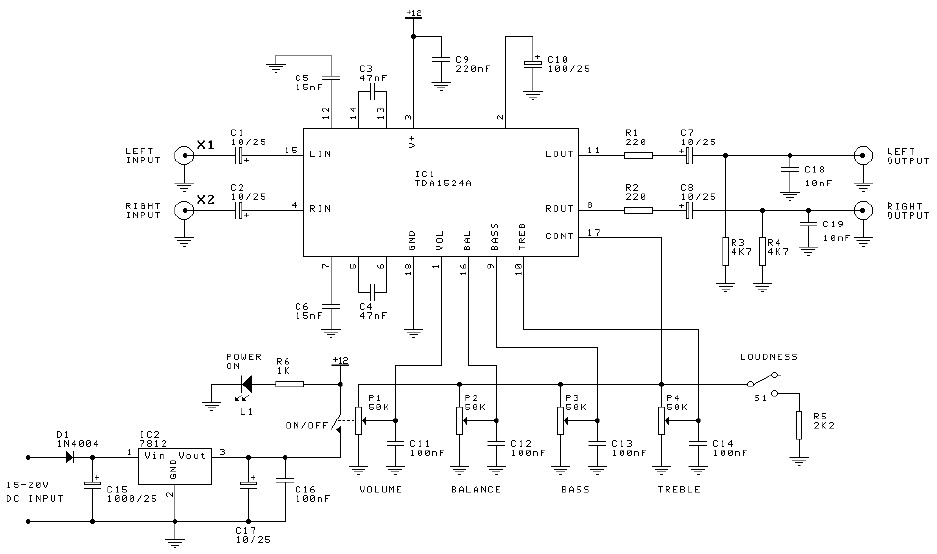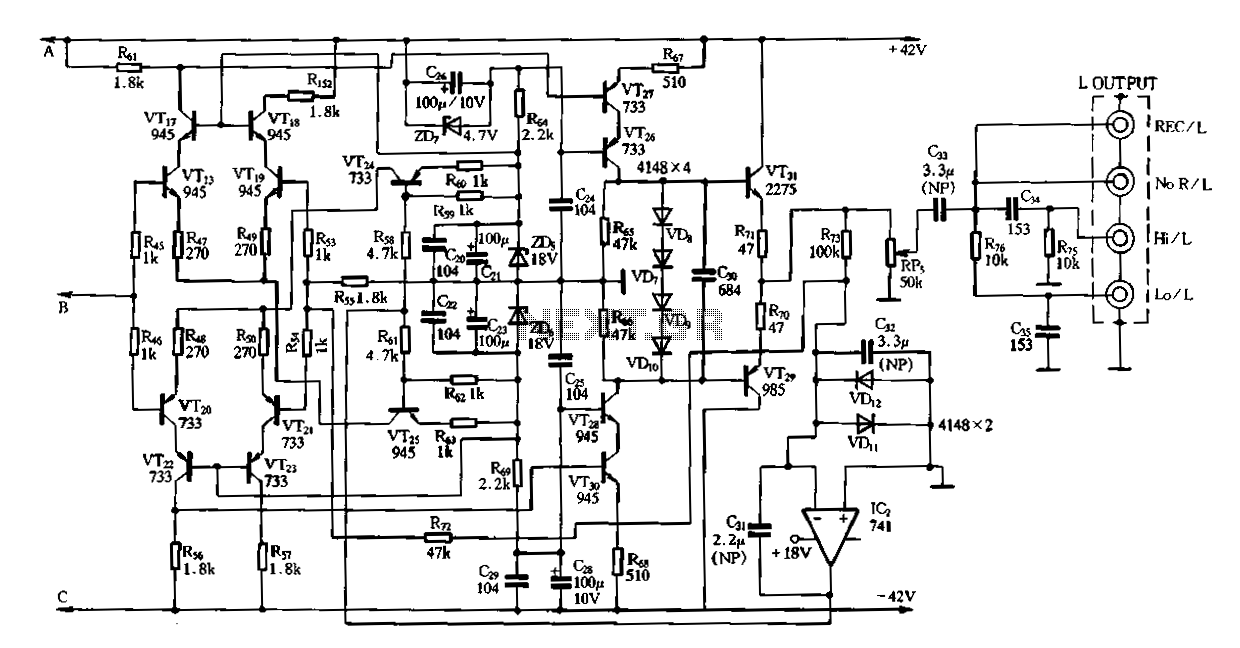
PREAMP
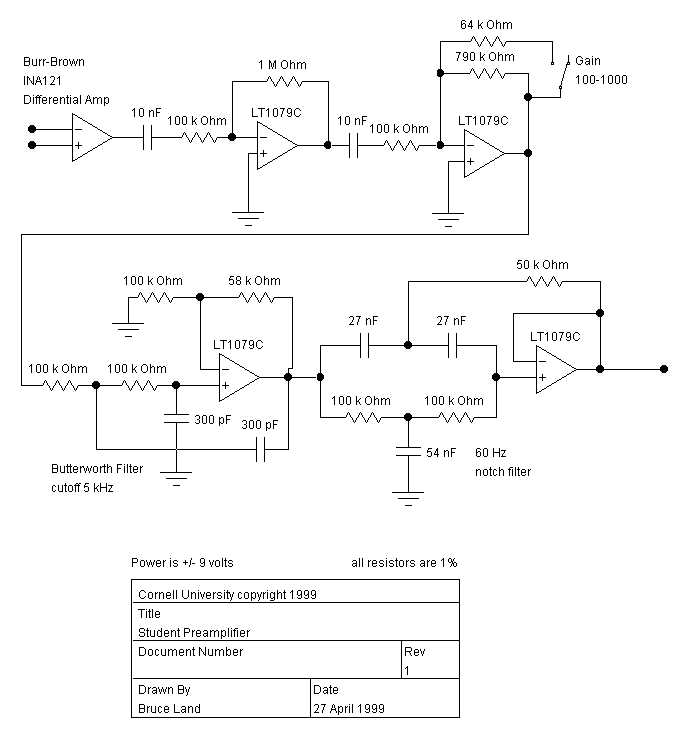
The input stage is critical for common-mode rejection and noise performance. A Burr-Brown INA121 differential amplifier is utilized, configured for a gain of 10. The input stage is DC coupled, and with a 9-volt supply, it can tolerate a differential DC offset of approximately one volt. Offsets in the range of a few hundred millivolts are typical, assuming the use of similar metals for the differential electrodes. The common-mode rejection of the circuit is determined by the Burr-Brown head-stage. Any operational amplifier (op-amp) in the circuit can be removed, along with its associated resistors and capacitors, if its function is not required. For example, if the 60 Hz notch filter is unnecessary, the output can be taken directly from the output of the third op-amp.
The described input stage employs a Burr-Brown INA121 differential amplifier, which is known for its high common-mode rejection ratio (CMRR) and low noise characteristics. The amplifier is configured to provide a gain of 10, which is suitable for amplifying small differential signals while minimizing the impact of common-mode noise. The DC coupling of the input stage allows for the direct processing of DC signals without the need for capacitive coupling, which can introduce phase shifts and limit bandwidth.
The tolerance for a differential DC offset of up to one volt indicates the robustness of the design in handling variations in electrode potentials, which is particularly relevant in applications such as bio-signal acquisition where electrode polarization can occur. Typical offsets in the range of a few hundred millivolts are acceptable, especially when using similar metal compositions for the electrodes, which helps to maintain the integrity of the differential measurement.
The circuit's common-mode rejection capability is contingent upon the performance of the Burr-Brown head-stage, ensuring that any common-mode signals present at the input are effectively rejected, allowing for accurate differential signal amplification. The modular design of the circuit permits flexibility; any op-amp can be selectively removed if its function is deemed unnecessary, streamlining the circuit for specific applications. For instance, in scenarios where a 60 Hz notch filter is not required, the output can be conveniently taken from the output of the third op-amp, thereby simplifying the design and potentially improving the overall signal processing efficiency.
This approach enhances the versatility of the circuit, making it adaptable to various signal processing needs while maintaining high performance in terms of noise rejection and signal integrity.The input stage is the most critical for common-mode rejection and noise. We used a Burr-Brown INA121 differential amplifier, set to a gain of 10. The input stage is DC coupled. With a 9-volt supply, a differential DC offset of up to about a volt is tolerable. Offsets of a few hundred millivolts are typical, assuming similar metals for the differe ntial electrodes. The common-mode rejection of the circuit is as good as the Burr-Brown head-stage. Any one of the opamps in the circuit can be removed (along with its supporting resistors and capacitors) if the function is not needed. For instance, if the 60 Hz notch filter is not needed, output may be taken from the output of the third op-amp.
🔗 External reference
The described input stage employs a Burr-Brown INA121 differential amplifier, which is known for its high common-mode rejection ratio (CMRR) and low noise characteristics. The amplifier is configured to provide a gain of 10, which is suitable for amplifying small differential signals while minimizing the impact of common-mode noise. The DC coupling of the input stage allows for the direct processing of DC signals without the need for capacitive coupling, which can introduce phase shifts and limit bandwidth.
The tolerance for a differential DC offset of up to one volt indicates the robustness of the design in handling variations in electrode potentials, which is particularly relevant in applications such as bio-signal acquisition where electrode polarization can occur. Typical offsets in the range of a few hundred millivolts are acceptable, especially when using similar metal compositions for the electrodes, which helps to maintain the integrity of the differential measurement.
The circuit's common-mode rejection capability is contingent upon the performance of the Burr-Brown head-stage, ensuring that any common-mode signals present at the input are effectively rejected, allowing for accurate differential signal amplification. The modular design of the circuit permits flexibility; any op-amp can be selectively removed if its function is deemed unnecessary, streamlining the circuit for specific applications. For instance, in scenarios where a 60 Hz notch filter is not required, the output can be conveniently taken from the output of the third op-amp, thereby simplifying the design and potentially improving the overall signal processing efficiency.
This approach enhances the versatility of the circuit, making it adaptable to various signal processing needs while maintaining high performance in terms of noise rejection and signal integrity.The input stage is the most critical for common-mode rejection and noise. We used a Burr-Brown INA121 differential amplifier, set to a gain of 10. The input stage is DC coupled. With a 9-volt supply, a differential DC offset of up to about a volt is tolerable. Offsets of a few hundred millivolts are typical, assuming similar metals for the differe ntial electrodes. The common-mode rejection of the circuit is as good as the Burr-Brown head-stage. Any one of the opamps in the circuit can be removed (along with its supporting resistors and capacitors) if the function is not needed. For instance, if the 60 Hz notch filter is not needed, output may be taken from the output of the third op-amp.
🔗 External reference

